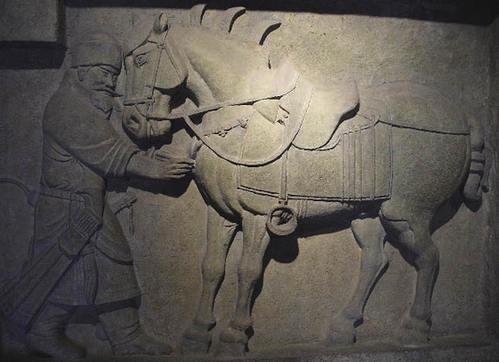| Anecdotes of Horses and Their Masters
By HUO JIANYING
DURING the Spring and Autumn and Warring States Periods 2,000 years ago, Chinese distinguished the size and power of the numerous vassal states by the number of horse-drawn military chariots (each drawn by four horses) they owned. The "thousand-chariot" states were large ones, while the "hundred-chariots" states were medium-sized to small ones. This reflects the thinking in ancient China that "the affairs of a state are determined by its military, and the state of its military is determined by horses." Indeed, as the main tools of agriculture, transport and the military, horses were of vital importance in the ancient states.
 |
| Saluzi, or Wind-speed Purple. |
"The Horse That Tramples the Hun"
In its early days, the Western Han Dynasty (206 BC-AD 25) had a serious shortage of horses, and its ministers and marshals had to ride on ox-drawn chariots. When 100,000 Hun cavalrymen invaded Western Han territory, founding emperor Liu Bang had to fight them with 400,000 infantry troops. When he was defeated, he solicited peace by offering monetary terms and a Han princess to marry the Hun khan. In the following decades, the Western Han government was dedicated to economic development, and imported a large number of fine-breed horses from the Western Regions. By the time of Emperor Wudi's reign (140-87 B.C.), the imperial government had a stock of 400,000 horses, not to mention a large number of privately raised ones, as described in historical records: "Horses owned by ordinary people were seen in streets and lanes, and large groups of them could also be found in farm fields."
The development of a huge stock of horses enabled Emperor Wudi to establish a cavalry, and in 133 B.C., he declared war on the Hun. The Han cavalry matched the enemy in terms of speed, fighting ability and equitation, while surpassing the Hun forces in number. The Han cavalry launched several assaults across the hundreds of kilometers of arid areas outside the Great Wall. In 119 B.C., Emperor Wudi ordered his last, decisive attack, dispatching 140,000 cavalrymen, in addition to hundreds of thousands of infantry and logistical troops, as well as 100,000 pack horses. The Han crusade occupied the Hun political center and forced them to flee to Beihai (around present-day Baikal Lake). The Han imperial court completely eradicated the Hun threat to its frontier agricultural districts when the last Hun fortress town was sacked in 36 B.C.
Huo Qubing was a famous general in the Han-Hun war. He led several successful cavalry attacks against the enemy and opened a passage to the Western Regions. In 117 B.C. he died at the age of 24. Emperor Wudi buried him in an attendant tomb of the Maoling Mausoleum built for his own death, so he and the general could be together in the nether world. In front of the young military leader's tomb were 16 large stone sculptures, the most famous being the "horse that tramples the Hun," done in a realistic and romantic style. It is an extant masterpiece of Western Han monumental stone carving. A life-sized horse and a dwarfed Hun soldier reflect the uneven conflict between the overwhelming Han forces and the vanquished Hun army. The stout and robust horse is 1.68 meters tall and 1.9 meters long, while the horrified Hun soldier curls up beneath its belly.
|
